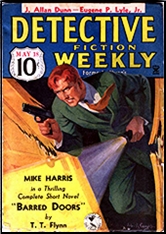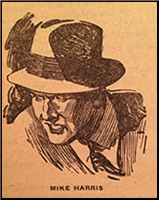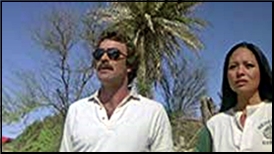Sun 9 Jun 2019
A Movie Review by Jonathan Lewis: WEREWOLF IN A GIRLS’ DORMITORY (1961).
Posted by Steve under Horror movies , Reviews[6] Comments
WEREWOLF IN A GIRLS’ DORMITORY. Cineriz, Italy, 1961, released as Lycanthropus; MGM, US, 1963. Barbara Lass, Carl Schell, Curt Lowens, Maureen O’Connor, Maurice Marsac. Director: Paolo Heusch.
Not nearly as salacious as the title would indicate, Werewolf in a Girls’ Dormitory is a surprisingly well-constructed Gothic horror movie. An Italian production featuring an international cast, the movie feels as if it’s an off-kilter amalgam of 1930s Universal Studios monster films, West German Edgar Wallace films, and early 1960s black and white horror cinema.
Sure, it’s schlocky. But it’s undoubtedly effective in creating a claustrophobic setting in which a werewolf preys upon persons associated with a reformatory for girls who have gotten in trouble with bourgeois morality and the law.
The trouble begins when Julian Olcott (Carl Schell) young, handsome physician is hired to teach science classes to the girls. Although the girls don’t know it, he has a shady past. Something about a young girl’s mysterious death at his last place of employment in Burlington, Vermont. But he’s seemingly a good guy and gets along well enough with the headmaster (Curt Lowens).
Within his first week of being on campus, there’s a sudden brutal murder. One of the girls, who seemingly was blackmailing a faculty member over their illicit love affair, is mauled to death. Some suspect the groundskeeper. Others suspect a wolf in the forest. Even the police inspector is puzzled.
Olcott teams up with one of his students, the inquisitive Priscilla (Barbara Lass) to investigate the strange happenings. Could it be that a werewolf is behind the mayhem? And what, if any, is Olcott’s connection to the deaths? After all, his field of scientific research prior to his employ at the school was (wait for it) lycanthropy.
Now I’m not going to try to sell you on this film. It’s not for everyone. What it does, though, it does well enough to hold a viewer’s attention. I also think there’s also a strange undercurrent of sadness throughout the proceedings, a Central European fatalism that I couldn’t quite put my finger on until I read the biographies of two of the leads. Barbara Lass was born Barbara Kwiatkowska-Lass in German-occupied Poland and was Roman Polanski’s first wife. Curt Lowens, who portrays the headmaster, was a German Jew who survived the Holocaust in hiding and went on to a lengthy acting career in which he often portrayed German soldiers.
Maybe it’s there, maybe it’s not. But I felt as if both of these two actors conveyed, even if unintentionally, a certain world weariness, one that is difficult to put in words, but capable of being seen if one knows where to look.



